Republic of China Military Academy
The Republic of China Military Academy (also known as Chinese Military Academy) is the military academy for the army of the Republic of China, located in Fengshan District, Kaohsiung. Previously known as the Whampoa Military Academy, the military academy produced many prestigious commanders who fought in many of China's conflicts in the 20th century, notably the Northern Expedition, the Second Sino-Japanese War and the Chinese Civil War.
中華民國陸軍軍官學校 | |
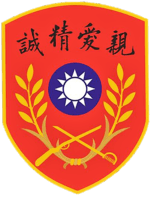 | |
Former names | Whampoa Military Academy (1924-1926) Central Military Academy (1927-1949) Chinese Workers and Peasants Military Academy |
|---|---|
| Motto | Fraternity, Devotion, Sincerity |
| Type | Service academy |
| Established | May 1, 1924 |
| Superintendent | Maj. Gen. Chang Chieh (張捷) |
| Location | Fengshan District, Kaohsiung , |
| Campus | Suburban |
| Website | www |
| Republic of China Military Academy | |||||||
|---|---|---|---|---|---|---|---|
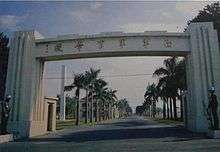 Main gate | |||||||
| Traditional Chinese | 中華民國陸軍軍官學校 | ||||||
| Simplified Chinese | 中华民国陆军军官学校 | ||||||
| Literal meaning | Chinese Republic Army Officer School | ||||||
| |||||||
| abbreviation | |||||||
| Traditional Chinese | 陸軍官校 | ||||||
| Literal meaning | Army Officer School | ||||||
| |||||||
| Whampoa Military Academy | |||||||
|---|---|---|---|---|---|---|---|
 Main gate | |||||||
| Traditional Chinese | 黃埔軍校 | ||||||
| Simplified Chinese | 黄埔军校 | ||||||
| Literal meaning | Yellow Port Army School | ||||||
| |||||||
The military academy was officially opened on May 1, 1924 under the Kuomintang (KMT), but the first lessons began on June 16, 1924. The inauguration was on Changzhou Island offshore from the Whampoa (Huangpu) dock in Guangzhou, thus earning its name. During the inaugural ceremonies, Sun Yat-sen (or Sun Yixian) delivered a speech that was later to become the lyrics of the national anthem of the Republic of China. It has been considered one of the most important institutions of the Republic of China together with the National Chengchi University, which is a prestigious incubator for senior civil service.
After the Republic of China government retreated from mainland China to Taiwan, the academy was re-established as the Republic of China Military Academy in Fengshan District, Kaohsiung.
Establishment



After the death of Yuan Shikai, China fragmented into numerous fiefdoms ruled by warlords. Sun Yat-sen attempted in 1917 and 1920 to set up a base in his native Guangdong to launch a northern campaign to unite China under his Three Principles of the People. However, his government remained militarily weaker than local warlords' armies. Calls by Sun for arms and money were ignored by the Western powers. Then, in 1921, the representative of Comintern, Henk Sneevliet (using the name Maring), met with Sun in Guangxi. He proposed setting up a military academy to train officers for the revolutionary army, which confirmed Sun's ideas. The Chinese Communist Party sent Li Dazhao and Lin Boqu to discuss with Sun and his party on how to set up the academy. In 1924, in the 1st National Congress of Kuomintang, the policy of alliance with the Soviet Union and CCP was passed as guidance for KMT. As a result, the final decision of the establishment of a military academy was made and a preparatory committee was set up accordingly. The money necessary for the construction and support of the Academy in 1924-1925 was provided by the Soviets.
|
Organization, training, and students
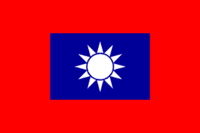
In the beginning, the Academy had only one department which provided soldiers with basic training. While the main Academy goal was preparation of infantry units, it also provided special classes for artillery, engineering, communication, logistical and machine gun units. A special department for preparation of political agitators was established later.

The academy concentrated the revolutionary military talents at the time. Sun took the job of Premier of this academy in person although it was just an honorary title. Sun's favorite and rising star Chiang Kai-shek was appointed the first commandant of the academy. Liao Zhongkai, the famous leftist in the Kuomintang and Sun's treasury secretary, was appointed as representative of KMT to the academy. Zhou Enlai, Hu Hanmin and Wang Jingwei were instructors in the political department. He Yingqin and Ye Jianying were once military instructors.
The serious lack of expert teachers was the biggest problem for the Academy. That is why lectures delivered by Soviet officers were extremely popular with students. A.S. Bubnov, G.I. Gilev, M.I. Dratvin, S.N. Naumov prepared lectures which explained the development of military thought throughout human history and the division between western and Soviet schools of military thought.

Soviet officers taught different military subjects in the Academy using their broad experience gained during the Russian Civil War. Among them were I. Vasilevich (Janovsky), N. Korneev, M. Nefedov, F. Kotov (Katyushin), P. Lunev, V. Akimov. Galina Kolchugina (wife of Vasily Blyukher who was commander-in-chief of all Soviet volunteer forces sent to China) read a course of lectures on political agitation.
The first two groups of students prepared by the Academy became the core for the formation of the first two National Revolutionary Army regiments (V.A. Stepanov was an advisor provided by the Soviet Union to help in this matter). The first two prepared groups of students included 500 officers, the third one had 800 officers and the fourth group had 2000.
Legendary graduates include Nationalist commanders Chen Cheng, Du Yuming, Xue Yue, Hu Zongnan, Hu Lien and Guan Linzheng and Communist commanders Lin Biao, Xu Xiangqian, Zuo Quan, Liu Zhidan and Chen Geng. The young cadets first showed their training and courage in the war against local warlord and dissident of Sun, Chen Jiongming and later the unification of Guangdong province. Then they made greater contributions in the Northern Expedition.

The Muslim Ma clique General Ma Zhongying, who commanded the 36th Division (National Revolutionary Army), attended the Whampoa military academy in Nanjing in 1929.[1][2][3]
Influence
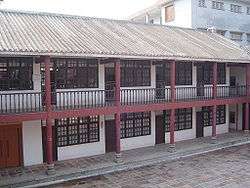
The Whampoa Military Academy plays an important role in Chinese history. It not only supplied many military commanders for both the KMT and CCP, but also its graduates have much more influence on both parties' policies and governance. Especially for Chiang and KMT, the Whampoa Clique was pivotal for his governance. It competed with other cliques of KMT such as the New Guangxi Clique led by Li Zongren and Bai Chongxi, CC Clique led by Chen Lifu and Chen Guofu, Politics Research Group led by Yang Yongtai (楊永泰) and Zhang Qun. At the same time, when the CCP built its first Red Army after the Nanchang Uprising in 1927 most of its commanders were from Whampoa, and in the following two decades, the CCP trained its army in the Whampoa way.
The motto of the academy "Camaraderie" (Chinese: 親愛精誠; lit.: 'Fraternity, Sincerity, Expertise, Integrity') was proclaimed by Sun Yat-sen at the opening ceremonies. The irony is that during the Chinese Civil War both the commanders from KMT and CCP were trained and educated in Whampoa. They fought for different beliefs and ideals although they used to live and study together like brothers in arms.
The academy also had significant influence over the 20th century history of other Asian countries. The fourth term of the Academy saw students not only from all parts of China, but also from different parts of Asia enroll. For example, there were 30 Koreans among them. Some of them were brought up in China, others were active participants during the national liberation movement of Korea in 1917-1926 and emigrated to China later only to take up arms for struggle for freedom of their country after their education was over.
A large number of students were originally from Vietnam. This group was led by the exiled leader to-be of the Communist Party of Vietnam and future leader of the Vietnamese struggle for independence, Ho Chi Minh.
Relocations
The original Whampoa Military Academy existed from 1924 to 1926. Over 6 terms it enrolled more than 7000. However, after Chiang Kai-shek purged the Chinese Communist Party during the Northern Expedition, the academy was moved (and renamed as Central Military Academy - CMA 中央陸軍軍官學校 and later as Chinese Workers and Peasants Military Academy) to the newly established capital in Nanjing after the defeat of the warlords in 1928. The academy moved again to Chengdu during the Japanese invasion.
Relocation to Taiwan
In 1950, after the Communist victory on mainland China and the establishment of the People's Republic of China, the academy was re-established in Fengshan, Kaohsiung as the Republic of China Military Academy (陸軍官校). The site of the original academy in Guangzhou is now a museum.
List of Superintendents
- Note: "Class year" refers to the alumnus's class year, which usually is the same year they graduated. However, in times of war, classes often graduate early.
- A "—" in the Class year column indicates a Superintendent who is not an alumnus of the Academy.
| # | Start | End | Name | Photo | Class year | Notability |
|---|---|---|---|---|---|---|
| 1. | 2 May 1924 | October 1947 | Generalissimo Chiang Kai-shek |  |
— | Generalissimo; 1st president of the Republic of China |
| 2. | October 1947 | September 1949 | Lt. Gen. Guan Linzheng (關麟徵) | 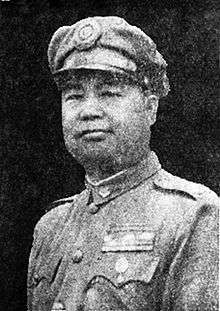 |
— | General; ROC Army Commander-in-Chief |
| 3. | September 1949 | December 1949 | Lt. Gen. Chang Yao-ming (張耀明) | 1924 | Lieutenant general; superintendent of the ROC Military Academy | |
| 4. | October 1950 | 31 October 1954 | Lt. Gen. Lo Yu-lun (羅友倫) | 1929 | General; ROC Combined Services Force Commander-in-Chief | |
| 5. | 1 September 1954 | 31 March 1957 | Lt. Gen. Hsieh Chao-chih (謝肇齊) | 1929 | Lieutenant general; vice president of the Army, Navy and Air Force Joint Staff University | |
| 6. | 1 April 1957 | 31 December 1960 | Lt. Gen. Hsu Ju-cheng (徐汝誠) | 1929 | Lieutenant general; deputy chief of the General Staff for Operations, MND-GSH | |
| 7. | 1 January 1961 | March 1965 | Lt. Gen. Ai Ai (艾靉) | 1926 | Lieutenant general; deputy executive Minister of National Defense | |
| 8. | March 1965 | 31 March 1970 | Lt. Gen. Chang Li-fu (張立夫) | 1929 | Lieutenant general; superintendent of the ROC Military Academy | |
| 9. | 1 April 1970 | February 1973 | Lt. Gen. Lin Chu-yao (林初耀) | 1933 | Lieutenant general; superintendent of the ROC Military Academy | |
| 10. | February 1973 | 31 March 1976 | Lt. Gen. Chin Tsu-hsi (秦祖熙) | 1937 | Lieutenant general; superintendent of the ROC Military Academy | |
| 11. | 1 April 1976 | December 1977 | Lt. Gen. Yen Pai-chien (言百謙) | 1941 | General; director of the Joint Operations Training Department, MND | |
| 12. | December 1977 | December 1979 | Lt. Gen. Hsu Li-nung (許歷農) | 1939 | General; director of the General Political Warfare Department, MND | |
| 13. | December 1979 | 30 June 1981 | Lt. Gen. Chu Chih-yuan (朱致遠) | 1939 | Lieutenant general; ROC Army Vice Commander-in-Chief | |
| 14. | 1 July 1981 | 30 June 1983 | Lt. Gen. Lu Kuang-yi (盧光義) | 1949 | Lieutenant general; director of the Military Intelligence Bureau, MND | |
| 15. | 1 July 1983 | 30 June 1985 | Lt. Gen. Huang Hsing-chiang (黃幸強) | 1949 | General; ROC Army Commander-in-Chief | |
| 16. | 1 July 1985 | December 1986 | Lt. Gen. Huang Yao-yu (黃耀羽) | 1952 | Lieutenant general; deputy director-general of the National Security Bureau | |
| 17. | December 1986 | 30 June 1989 | Lt. Gen. Tang Yuan-pu (湯元普) | 1960 | Lieutenant general; superintendent of the ROC Military Academy | |
| 18. | 1 July 1989 | 60 June 1991 | Lt. Gen. Hu Chia-chi (胡家麒) | 1961 | Lieutenant general; superintendent of the ROC Military Academy | |
| 19. | 1 July 1991 | September 1993 | Lt. Gen. Yang Te-chih (楊德智) | 1964 | General; ROC Combined Services Force Commander-in-Chief | |
| 20. | September 1993 | July 1996 | Lt. Gen. Ma Teng-ho (馬登鶴) | 1960 | Lieutenant general; ROC Combined Services Force Vice Commander-in-Chief | |
| 21. | July 1996 | July 1997 | Lt. Gen. Tung Chao-yang (童兆陽) | 1965 | Lieutenant general; ROC Army Vice Commander-in-Chief | |
| 22. | July 1997 | January 1998 | Lt. Gen. Ting Yu-chou (丁渝洲) | 1966 | General; secretary-general of the National Security Council | |
| 23. | January 1998 | 28 February 2002 | Lt. Gen. Chang Yueh-heng (張岳衡) | 1965 | Lieutenant general; superintendent of the ROC Military Academy | |
| 24. | 1 March 2002 | 30 June 2005 | Lt. Gen. Yang Kuo-chiang (楊國強) | 1972 | Lieutenant general; incumbent director-general of the National Security Bureau | |
| 25. | 1 July 2005 | 30 June 2006 | Lt. Gen. Wang Ken-lin (王根林) | 1971 | Lieutenant general; superintendent of the ROC Military Academy | |
| acting | 1 July 2006 | 31 July 2006 | Lt. Gen. Chia Fu-yi (賈輔義) | 1970 | Lieutenant general; superintendent of the ROC Military Academy (acting) The rank of the superintendent was demoted from lieutenant general to major general by the disarmaments policy of the then President Chen Shui-bian. | |
| 26. | 1 October 2006 | July 2010 | Maj. Gen. Chen Liang-pei (陳良沛) | 1979 | Major general; superintendent of the ROC Military Academy | |
| 27. | July 2010 | 30 June 2012 | Maj. Gen. Chuan Tzu-jui (全子瑞) |  |
1981 | Lieutenant general; incumbent ROC Army Chief of Staff |
| 28. | 1 July 2012 | February 2015 | Maj. Gen. Liu Te-king (劉得金) | 1983 | Lieutenant general; incumbent director of the Telecommunications Development Office, MND-GSH | |
| 29. | February 2015 | present | Maj. Gen. Chang Chieh (張捷) | 1985 | Major general; incumbent superintendent of the ROC Military Academy | |
Faculties
- Center for General Education
- Department of Civil Engineering
- Department of Physics
- Department of Foreign Languages
- Department of Political Science
- Department of Management Science
- Department of Chemistry
- Department of Electrical Engineering
- Department of Mechanical Engineering
- Department of Information Management[4]
Notable alumni
- Lee Shying-jow, Minister of Veterans Affairs Council (2016-2018)
- Justin Yifu Lin, Chinese economist
Transportation
The academy is accessible within walking distance South of Dadong Station of the Kaohsiung MRT.
See also
- Republic of China Naval Academy
- Republic of China Air Force Academy
- National Revolutionary Army
- Yunnan Military Academy, founded in 1909
- Baoding Military Academy, founded in 1902
- Warlord era
- Sino-German cooperation
- History of the Republic of China
- Military of the Republic of China
- List of universities in Taiwan
References
- James A. Millward (2007). Eurasian crossroads: a history of Xinjiang. Columbia University Press. p. 193. ISBN 0-231-13924-1.
- Michael Dillon (1999). China's Muslim Hui community: migration, settlement and sects. Richmond: Curzon Press. p. 89. ISBN 0-7007-1026-4.
- Christian Tyler (2004). Wild West China: the taming of Xinjiang. New Brunswick, New Jersey: Rutgers University Press. p. 98. ISBN 0-8135-3533-6.
- http://www.cma.edu.tw/en_university_list.php
External links
- ROCMA (Chinese) - Official Site of Republic of China Military Academy (Chinese)
- ROCMA (English - Official Site of Republic of China Military Academy (English)
| Wikimedia Commons has media related to |